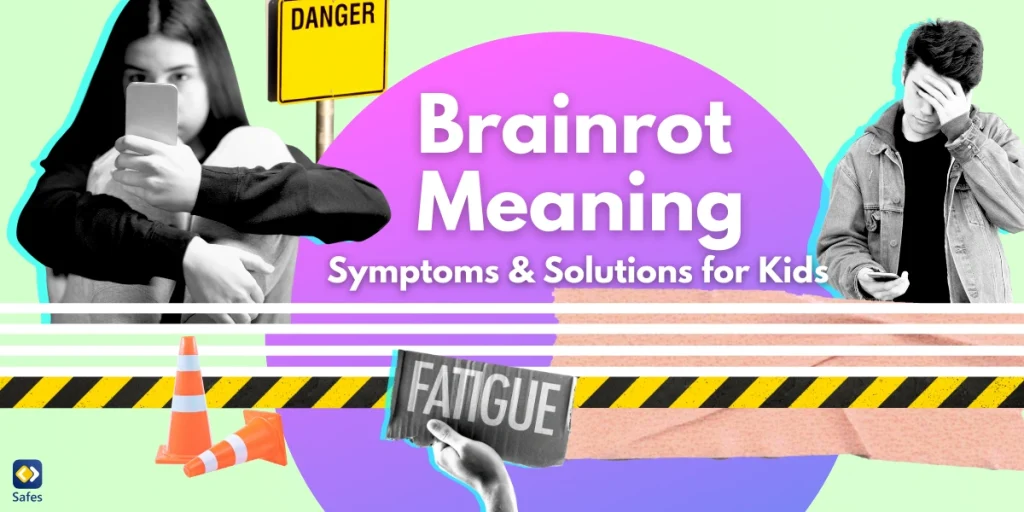Ever heard of “brainrot” and wondered what it means? No, it’s not a real illness, but it’s a term some people use to describe when kids feel mentally tired, overwhelmed, or just plain stuck. It’s like when your brain feels like it’s been on overdrive and can’t seem to switch off. This phenomenon has become a serious issue in the past few years as it can affect a child’s behavior, academic performance, and future.
In this blog, we’ll break down brainrot meaning, what signs to look out for, and most importantly, how to help kids feel better and get back to their happy, energetic life. Let’s first learn what brainrot is all about.
What Is the Meaning of Brain Rot?
Brainrot is a term that’s often used informally to describe a state of mental fatigue or decline. It’s not a medical diagnosis, but rather a way to talk about feeling mentally worn out or unable to think clearly. This can happen for several reasons, such as:
- Spending too much time on screens or social media
- Constant stress or having too many tasks
- Not engaging in activities that challenge your mind
Your kid may spend hours scrolling through social media every day, watching countless short videos, and reading random posts. After a while, they start to feel like their brain is constantly buzzing but not really focused on anything. They find it hard to concentrate on their homework and feel mentally drained. This is one of the brain rot examples, in which your kid might be experiencing brainrot due to overuse of digital media.

How Does Social Media Lead to Brainrot?
According to an article about the impact of the digital revolution on the human brain and behavior, how we use our brains can be influenced by our digital media habits. It’s known that heavy use of digital devices can change our brains because of how neurons adapt. Social media platforms offer a never-ending stream of content, which can overwhelm your brain. This constant bombardment can make it hard to focus on one task for a long time.
The quick, flashy nature of posts and videos can train your brain to expect constant, rapid stimulation, leading to shortened attention span. Moreover, seeing other people’s images and videos about their lives develops comparison and self-doubt. This will cause social media brain rot, followed by stress and anxiety, which negatively impact mental well-being.
What Are Brain Rot Symptoms?
As mentioned before, brain rot isn’t a real medical condition, but the term is used to describe feelings of mental fatigue or sluggishness. Here are some common symptoms of Gen Z brainrot:
- Difficulty Concentrating: Struggling to focus on tasks or having a hard time staying engaged with activities.
- Mental Fatigue: Feeling mentally drained or tired, even after rest or sleep.
- Short Attention Span: Finding it hard to keep their attention on one thing for an extended period.
- Forgetfulness: Having trouble remembering things or forgetting important details.
- Decreased Motivation: Feeling less interested in activities or tasks that you usually enjoy.
- Irritability: Becoming easily frustrated or upset over minor issues.
- Lack of Creativity: Struggling to come up with new ideas or solutions to problems.
These symptoms can be caused by various factors, like overuse of digital devices, stress, or not getting enough mental stimulation. Among these causes, social media has the biggest role in appearing these symptoms in children.
What Is Tik Tok Brainrot?
TikTok, Instagram, and YouTube are some of the most popular platforms for children. Therefore, they are most likely to affect your kids, leading to brain rot and all the related issues. Suppose your child uses TikTok excessively and consistently. In that case, they may be dealing with a certain type of mental fatigue called TikTok Brainrot. So, you’ll know that they’re constantly exposed to short, fast-paced videos that can lead to short attention spans and missing real-life interactions, as well as TikTok addiction.

How to Save Your Kid from Brainrot Symptoms?
If you’re worried about brainrot symptoms in your child due to excessive screen time or other factors, here are some practical steps to help keep their mind healthy.
Set Screen Time Limits
Establish daily rules for how long your child can use screens to help prevent excessive screen time. This screen time limit is essential to minimize the risks of brainrot in children. For instance, the American Academy of Pediatrics recommends no more than one to two hours of recreational screen time per day for children. Consistently enforcing these limits ensures that your child has time for other enriching activities, promoting a healthier balance between digital and real-world experiences.
Encourage Breaks & Promote Other Activities
Your child needs regular breaks from screens to prevent brainrot symptoms and reduce mental strain. You can also teach them the 20-20-20 rule, where your child looks at something 20 feet away for at least 20 seconds every 20 minutes. This helps alleviate eye strain and mental fatigue. Alongside this, make sure to encourage a variety of offline activities such as playing outdoors, engaging in creative hobbies, or reading books to help them have diverse experiences that stimulate their mind in different ways.
Foster Real-Life Social Interaction
You should never neglect to foster real-life social interactions for your child, which helps them develop emotional and social skills. By arranging playdates, family activities, and group events, you provide opportunities for your child to build strong relationships and develop essential social skills. Face-to-face interactions help mitigate the effects of excessive screen time and offer meaningful connections that digital platforms cannot fully replicate.
Create Tech-Free Zones
Specify some areas in your house, like the dining room and bedrooms, as tech-free zones to encourage family meals and conversations without digital distractions. This helps your child have better sleep hygiene and enhances the quality of family time. When you create spaces where screens are not allowed, you encourage your child to engage more fully in face-to-face interactions and other offline activities.
Final Word
Now that you know the meaning of brainrot and how social media affects kids in different ways, you can make an informed decision about your child’s digital habits. Balancing screen time with healthy activities is crucial to preventing brainrot symptoms in kids. Setting screen time limits, encouraging regular breaks, promoting engaging offline activities, fostering real-life social interactions, and creating tech-free zones, all can help your child maintain a well-rounded and healthy lifestyle. These practices not only protect against mental fatigue and attention issues but also support overall emotional and social development.
To make managing screen time easier and more effective, you can benefit from Safes, our comprehensive parental control app. Safes allows you to set screen time limits, monitor your child’s online activities, and enforce tech-free zones effortlessly. With features designed to help you balance digital use and encourage healthier habits, Safes supports your efforts to keep your child’s mind sharp and their well-being intact.
If you have tried Windows parental controls or similar settings on other devices, you’ll find Safes a more helpful and comprehensive solution to control your child’s online activities and balance their real and digital life.
Download Safes today for both Android and iOS and start your free trial to experience how easy it can be to maintain a balanced digital lifestyle for your family.




